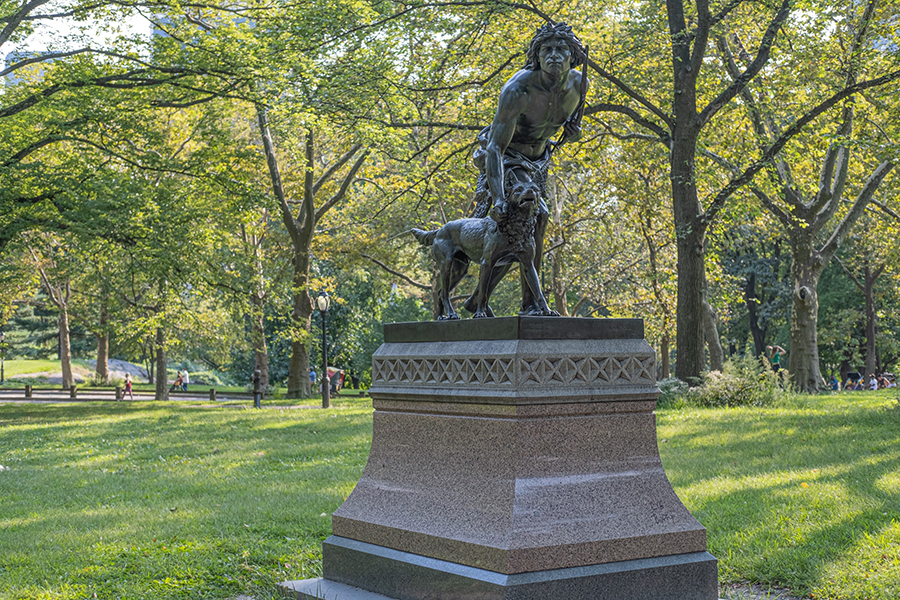Kelvin Parnell Jr.
Settler Sculptors and America’s Bronze Age
When a long-established imperial power falls and a new one assumes its place, the lasting presence of the former does not fade so easily. As the new nation continues to define itself over the ensuing generations, it is natural to ask what has changed and wise to ask what has remained the same. Perhaps, it might be wiser still to ask what has been kept and refashioned—made anew—to suit the needs of the assuming order. These philosophical questions have guided my current research, which seeks to trace the ways in which the United States has used sculpture as a means to define and give visual language to its identity as an imperial nation. Finishing my dissertation at the Center, in the nation’s capital, has thus been a fitting end to my graduate studies.

Henry Kirke Brown, De Witt Clinton monument (detail), 1853, bronze, Green-Wood Cemetery, Brooklyn. Photo: Kelvin Parnell Jr.
Over the course of my fellowship, I completed my dissertation, “Casting Bronze, Recasting Race: American Sculpture and the Bronze Economy (1840–1890),” which centers the visual and social histories of bronze in the United States within multiple regimes of value, raising questions about the constitutive relationships between American empire, material commodities, sculpture, and evolving racial discourses in the 19th century. To do so, I interrogate the student-teacher relationship between 19th-century American sculptors Henry Kirke Brown (1814–1886) and John Quincy Adams Ward (1830–1910), situating them as progenitors of racialized subjects in American bronze sculpture through their depictions of Native and Black figures. Although my dissertation centers around these two individuals, it is not a biographical endeavor. By privileging their teacher-student relationship, I examine the development of a shared formal language used to depict and differentiate three central American racial identities and political categories in the mid-19th century: Whiteness, Indigeneity, and Blackness. Through these artists’ archives and images, one can observe the ways in which their audiences became captivated by the perceived racial authenticity of their bronze subjects, allowing them to become, to borrow art historian Linda Kim’s moniker, “race experts” during this period. Through their alleged encounters with Native and Black peoples and the resulting images, Brown and Ward were praised by the American art world as sculptors primed with the unique acuity to deliver the essential racial “Other” to the American people in three dimensions.

John Quincy Adams Ward, The Indian Hunter, 1866, bronze, Central Park, New York. Photo: Kelvin Parnell Jr.
As the first study to center bronze in its material, art-theoretical, and metaphorical aspects, my dissertation shows the pivotal role played by bronze in American sculptural production and probes: why and how bronze became emblematic of American national identity, the artistic and socioeconomic implications of its deployment, and its representational effects on perceptions of American national identity and racial alterity. I focus my study on New York State as the epicenter for US artistic, economic, and political power in order to interrogate Brown’s and Ward’s works through the lens of a burgeoning bronze economy brought about by the country’s settler-colonial pursuits and its efforts to expand American borders westward. In so doing, I excavate the entanglement of materiality and economics with race and sculpture to offer a new account of how American bronze sculpture—in both the production and reception of statuettes, life-size works, and public monuments—functioned as a socialization mechanism for constructing, maintaining, and strengthening gender and racial hierarchies in the United States.
During the first year of my fellowship, I published “Good Mourning: The Commemorative and Funereal Sculptures of Augustus Saint-Gaudens and Daniel Chester French,” in Monuments and Myths: The America of Sculptors Daniel Chester French and Augustus Saint-Gaudens (2023). In this essay, I began to reorient my thinking about the national function that bronze sculptures, particularly monuments and memorials, played in collective mourning. I concluded that erecting statues in public and semiprivate spaces of mourning and communal reflection, like cemeteries and public squares, became a key way Americans processed national grief and crafted cohesive national identities during the late 19th century. But what about memorials to triumphal histories? Could sentimentality and grief be used to establish narratives of a glorious past?
Prior to my residency, I took a research trip to three built environments to examine three sculptures central to a chapter I completed at the Center: “Green-Wood Cemetery, Central Park, and Cooper Park.” I examine two works by the artists at the center of this study: Brown’s De Witt Clinton monument (1853) located at Brooklyn’s Green-Wood Cemetery and Ward’s Indian Hunter (1866), which lies in the heart of New York City’s Central Park. In the chapter, I argue that when interpreting these monumental statues alongside the historical legacies of these sacralized, public environs, we treat these locales as settler spaces. Furthermore, in considering how these sculptures exalt the imperial history and contemporary presence of the nation by depicting the dispossession of Native peoples, it becomes clear that they should be regarded as settler monuments. I examine how these monumental statues share an articulation of imperial power and vision filtered through idyllic, curated wildness spaces, allowing them to enthrall passersby with seemingly innocuous projections of America’s “heroic” settler past and the nobility of the romanticized “vanished” Native subject. Combined, the built environments of mid-19th-century cemeteries and parks and the monumental sculptures placed within afford a unique phenomenological encounter with racialized art objects and compel a particular settler-colonial viewpoint regarding US history and the nation’s relationship to the Indigenous populations it has destroyed and dispossessed.
University of Virginia
Wyeth Fellow, 2022–2024
In fall 2024, Kelvin Parnell Jr. will join the University of Arkansas’s Art History program as the Endowed Assistant Professor in Arts of the Americas.
